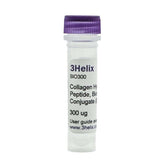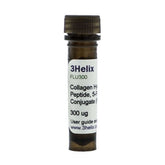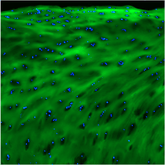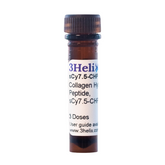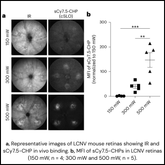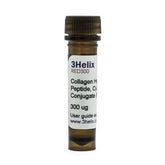Intracellular Hydroxyproline Imprinting Following Resolution of Bleomycin-induced Pulmonary Fibrosis
Dr. Yong-Su Jin and team used CHPs in their research to follow collagen synthesis and degradation through an IPF (idiopathic pulmonary fibrosis) model using bleomycin and the resolution of fibrosis thereafter. Because biochemical assays (the golden standard) show consistently high levels of hydroxyproline content, it fails to detect that fibrosis can resolve itself. Jin et al. used CHPs and Sirius red in histopathology to observe that collagen levels increase four weeks post injury but after four weeks, collagen is mostly being degraded instead of synthesized. This contradicts with current theories that fibrosis does not resolve. With the evidence shown from using CHPs, Jin can hypothesize that biochemical assays measuring hydroxyproline do not accurately reflect collagen content in the resolution phase of fibrosis based on incomplete degradation of the collagen molecules.
ABSTRACT
Idiopathic pulmonary fibrosis (IPF) is a fatal lung disease with few treatment options. The poor success in developing anti-IPF strategies have impelled researchers to reconsider the importance of choice for animal model and assessment methodologies. Currently, it is still not settled whether the bleomycin-induced lung fibrosis mouse model finally returns to resolution. This study aimed to follow the dynamic fibrotic features of BLM (Bleomycin-treated mouse lungs) with extended durations through a combination of the latest technologies (micro-CT imaging and histological detection of degraded collagens) with traditional methods.
In addition, we also applied immunohistochemistry to explore the distribution of all hydroxyproline-containing molecules. As determined by classical biochemical method, total lung hydroxyproline contents reached peak at 4-week after bleomycin injury and maintained a steady high level thereafter until the end of the experiments (16-week).
This result seemed to partially contradict with the changes of other fibrosis evaluation parameters, which indicated a gradual degradation of collagens and a recovery of lung aeration post the fibrosis peak. This inconsistency was well reconciled by our data from immunostaining against hydroxyproline and a fluorescent peptide staining against degraded collagen, together showing large amounts of hydroxyproline-rich degraded collagen fragments detained and enriched within the intracellular regions at 10- or 16-week, rather than at 4-week post the BLM-treatment.
Hence, our present data not only offer respiratory researchers a new perspective towards the resolution nature of mouse lung fibrosis, but also remind them to be cautious while using hydroxyproline content assay to evaluate the severity of fibrosis.
CHECK OUT THE FULL ARTICLE HERE
